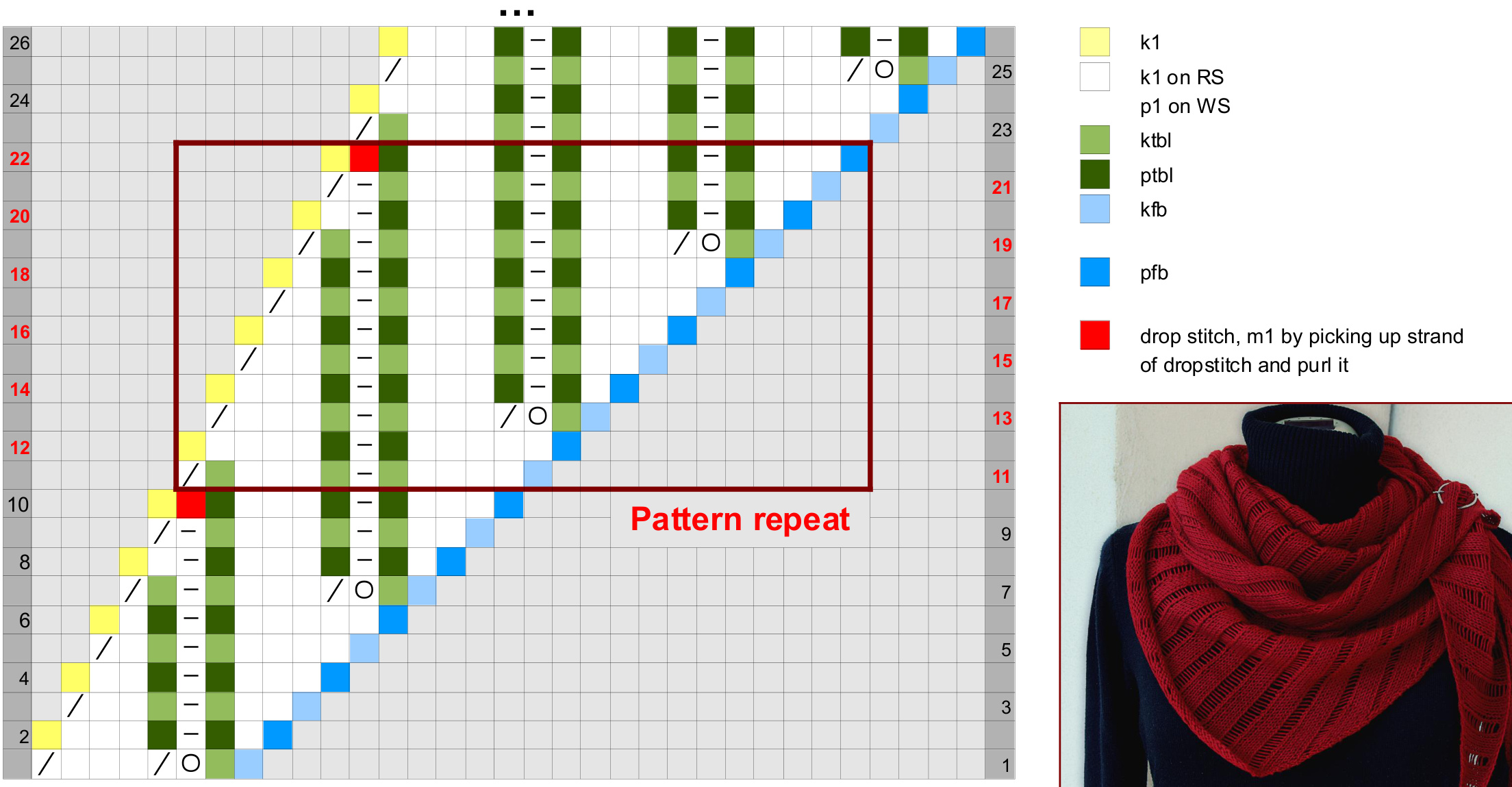KVOTHE
My stash is a miracle. Really. Although I really knit a lot my stash isn't getting smaller. There's always just another skein or ball of yarn I can't resist to buy:-) One of these beautiful yarn treasures in my stash was one skein of Wollmeise Twin in "Herzblut". The yarn has a beautiful warm dark red colour, is soft enough for a scarf and one skein has the perfect yardage for a not-too-big scarf. But what scarf...that was the question. I decided to knit it triangular, not to wide/tall but with a comfortable length to wrap it around my shoulders or neck more than once on cold days. The pattern should have been easy and with a little of "Lace" in it so that the scarf can be worn in the middle European spring time, too. A yardage between 400 and 500 m in fingering weight should have been enough for the scarf. KVotHE is an easy knitting pattern. You start at one pointed side with few stitches. Then you increase regularly in each row on one side and decrease every other row on the other side to make it asymmectrical. Just follow the pattern until your scarf has the right length or width or your yarn runs short...or another yarn treasure begs for being knitted. If you block the scarf very aggressively after the first wash it will be very asymmetrical and very long but if you block it just enough to accentuate the drop stitches the form won't get that asymmetrical. While I was finishing the pattern and knitting the scarf I thought about a pattern name but I had absolutely no idea. That's why I had to
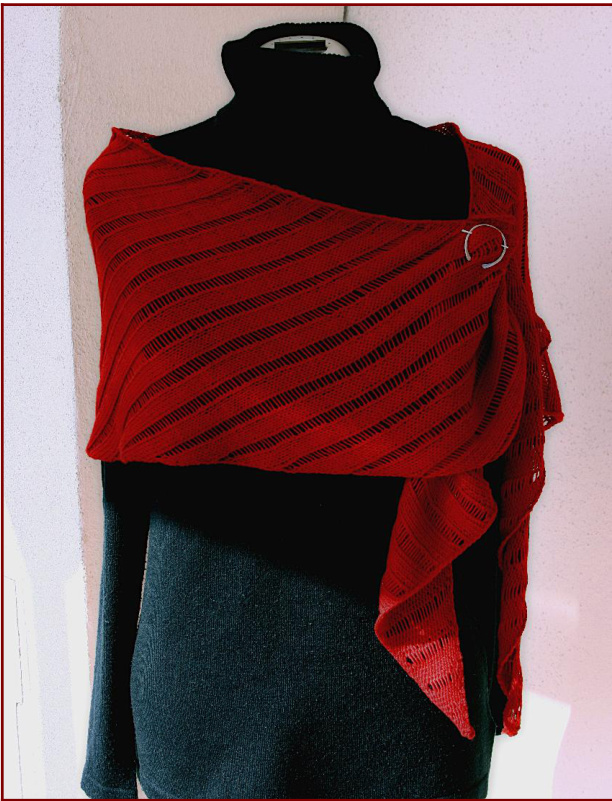
borrow one and so it is named KvotHe. Kvothe is the main character of the novel "The name of the wind" and the Kingkiller Chronicle trilogy I've read last year. It is written by Patrick Rothfuss'. Kvothe has (flame) red hair, a sometimes weird behaviour, some strengths and weaknesses and is higly gifted with musical and magical talent. KvotHe is (blood) red, has a weird form, some weaknesses - for example, the ends are curling up which I don't like - and there's no magic to/with this scarf;-) At the beginning I had concerns about how to wear this scarf. Meanwhile we're the best friends, my skew-whiff scarf and me. I hope you have the same pleasure in knitting and wearing this scarf than I had.
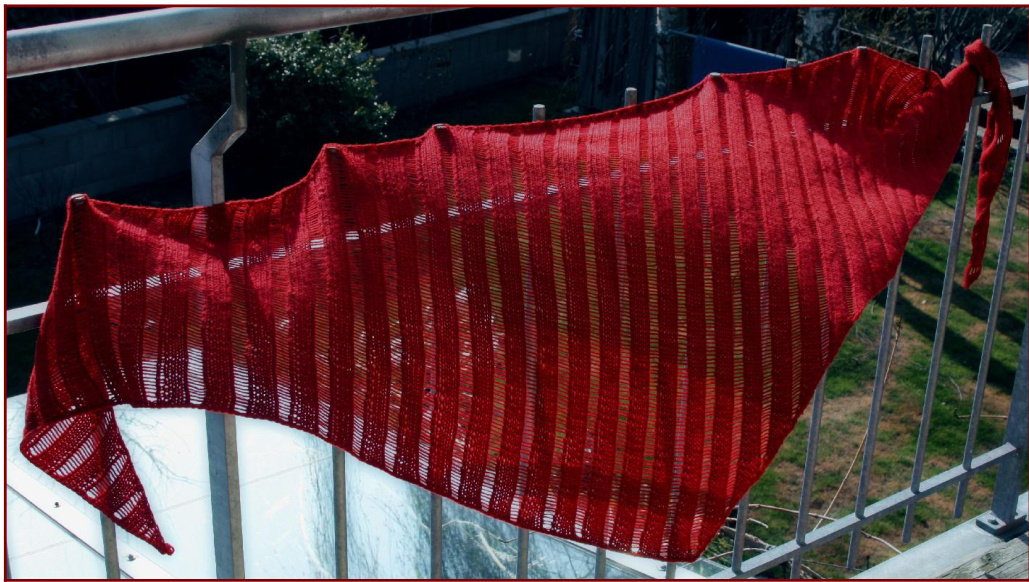
Yours Carmen Of course everybody can adjust the pattern to his or her own taste. Maybe you want to replace ktbl with k1 and ptbl with p1 if you don't like to knit/purl in the back loop. You will get a different look but it's much faster to knit. I'm very sorry but I had no test knitters for this scarf. If you find an error or if you have any question don't hesitate to contact me at csmolne@web.de. On Ravelry my name is acacia09.
Material
· 1 skein of 150 g Wollmeise Twin, 80% Wool 20% Polyamide, colour "Herzblut", LL approx. 465 m. Other yarn with similar yardage is also suitable, e.g. fingering weight yarn for sox or lace yarn (4ply/2ply). · 3 mm circular xknitting needles with any length, e.g. 80 cm. · Tapestry needle to weave in the ends of the yarn.
Dimensions
; triangular and asymmetrical. The scarf shown on the photos has the following dimensior Base of triangle: 190 cm Shorter side: 90 cm Height/Depth:48 cmWider side:140 cm 25 repeats of the basic pattern. Before binding offthere were 164 stitches on the needler
Level of difficulty
The following techniques are needed: Casting on stitches, binding off stitches, knitting and purling, knitting two stitches together, knitting a yarn over, knitting and purling through the back loop of a stitch.
Directions
Beginning:
Cast on 9 stitches. Knit 1 stitch, purl 8 stitches (wrong side). Row 1: kfb, ktbl, yo, k2tog, k3, k2tog [9] Row 2: k1, p3, ptbl, k1, ptbl, p1, pfb [10] Row 3: kfb, k2, ktbl, p1, ktbl, k2, k2tog [10] Row 4: k1, p2, ptbl, k1, ptbl, p3, pfb [11] Row 5: kfb, k4, ktbl, p1, ktbl, k1, k2tog [11] Row 6: k1, p1, ptbl, k1, ptbl, p5, pfb [12] Row 7: kfb, ktbl, yo, k2tog, k3, ktbl, p1, ktbl, k2tog [12] Row 8: k1, p1, k1, ptbl, p3, ptbl, k1, ptbl, p1, pfb [13] Row 9: kfb, k2, ktbl, p1, ktbl, k3, ktbl, p1, k2tog [13] Row 10: k1, dsp1, ptbl, p3, ptbl, k1, ptbl, p3, pfb [14]
Basic pattern:
Row 11: kfb, k4, [ktbl, p1, ktbl, k3], ... , ktbl, k2tog [14/20/26..] Row 12: k1, p4, [ptbl, k1, ptbl, p3], .., p2, pfb [15/21/27...] Row 13: kfb, ktbl, yo, k2tog, k3, [ktbl, p1, ktbl, k3], ..., k2tog [15/21/27...] Row 14: k1, p3, [ptbl, k1, ptbl, p3], .., ptbl, k1, ptbl, p1, pfb [16/22/28...] Row 15: kfb, k2, [ktbl, p1, ktbl, k3],..., ktbl, p1, ktbl, k2, k2tog [16/22/28..] Row 16: k1, p2, [ptbl, k1, ptbl, p3], .., ptbl, k1, ptbl, p3, pfb [17/23/29...] Row 17: kfb, k4, [ktbl, p1, ktbl, k3], .., ktbl, p1, ktbl, k1, k2tog [17/23/29..] Row 18: k1, p1, [ptbl, k1, ptbl, p3], .., ptbl, k1, ptbl, p5, pfb [18/24/30...] Row 19: kfb, ktbl, yo, k2tog, k3, [ktbl, p1, ktbl, k3],..., ktbl, p1, ktbl, k2tog [18/24/30...] Row 20: k1, p1, k1, ptbl, p3, [ptbl, k1, ptbl, p3], .., ptbl, k1, ptbl, p1, pfb [19/25/31...] Row 21: kfb, k2, [ktbl, p1, ktbl, k3], [ktbl, p1, ktbl, k3], ., ktbl, p1, k2tog [19/25/31...] Row 22: k1, dsp1, ptbl, p3, [ptbl, k1, ptbl, p3], [ptbl, k1, ptbl, p3], .., pfb [20/26/32..] Inside the (square) brackets you can see the number of stitches on the needles at the end of a row (for control). Repeat the rows 11-22 of the basic pattern until your scarf reaches your preferred length or width. You need only a small amount of yarn for binding off (enough for one or two rows). With each repeat 6 stitches are added. Knit these additional 6 stitches like the bold printed part inside of the (square) brackets (after finishing the pattern repeat).
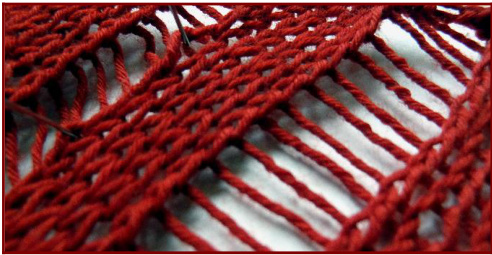
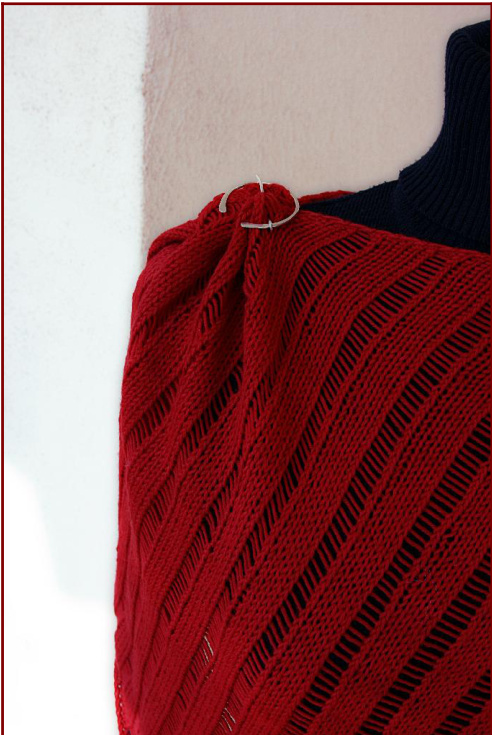
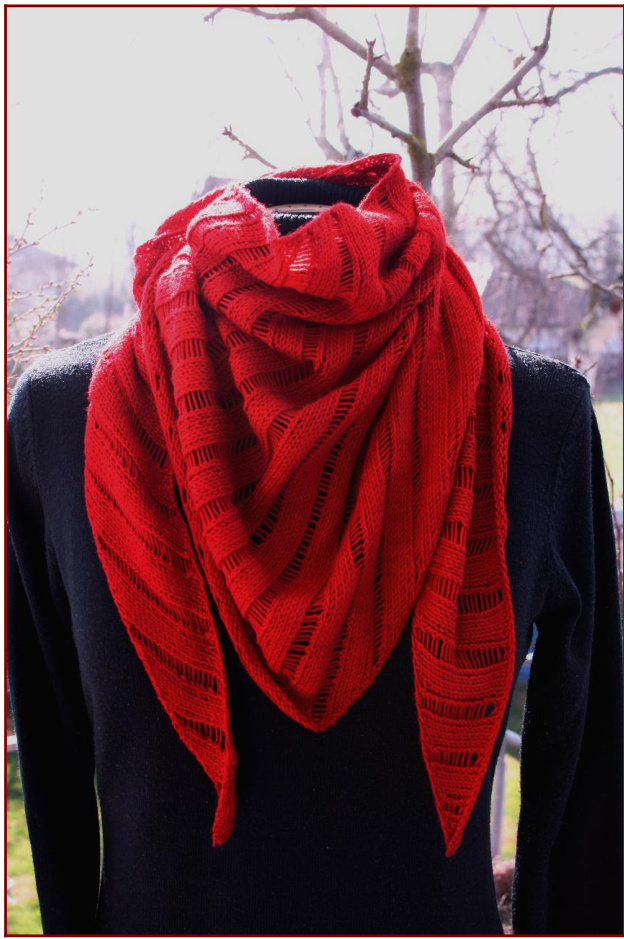
| Abbreviations | |
| k1 | knit one stitch |
| p1 | The number behind the k is the number of stitches to knit. |
| purl one stitch | |
| The number behind the p is the number of stitches to purl. | |
| ktbl | knit one stitch through back loop Knit through back loop of stitch from right to left |
| ptbl | purl one stitch through back loop |
| kfb | Purl through back loop of stitch from left to right. knit front back |
| pfb | k1 and ktbl into the same stitch (1 stitch increased). purl front back |
| k2tog | p1 and ptbl into the same stitch (1 stitch increased). knit two stitches together knit two stitches together: knit from left to right with the |
| yo | right needle through the next 2 stitches on the left needle (1 stitch decreased). makeoneyarn over Increase 1 stitch by building a yarn over. drop stitch, pick up strand and purl one stitch Drop one stitch, pick up the strand and purl a stitch into this strand. Instead of purling through back loop pickupstrandfromfrontlefttobackrightinsteadof from back left to front right like you would do normally. |
| dsp12 | |
When the scarf reaches the preferred size you can bind off all stitches loosely. While binding off on the wrong side you can work the drop stitches like written in the pattern. If you prefer to bind off on the right side, you can do the following: Drop all purled stitches, pick up strand from each dropped stitch and knit it through the back loop (ktbl). Then bind off the stitch. For the scarf on the photos I stopped knitting the basic pattern after the 25h repeat of row 22. Then I knitted the next row (right side) without kfb at the start of the row but with all the ktbl stitches, dropped the purled stitches and made a ktbl with the picked up strands. The next row (wrong side) I skipped again the increasing (at the end = pfb) and bound off loosely - loosely is important for the blocking. On the next page there's a picture of the graphical pattern. There are row numbers on both sides of the graphic. Odd numbers are right side rows (right side of graphic), even numbers are wrong side rows (left side of graphic). Right side rows are worked from right to left, wrong side rows from left to right. The pattern includes the border stitches - you don't have to knit extra border stitches (but you can if you prefer to). The basic patte starts at row 11.One patternrepeat has 12 rows.There are 12 stitches increased during one pattern repeat (each row 1 stitch) and 6 stitches decreased (every other row 1 stitch) which results in a total increase of 6 stitches per 12 rows.
| 26 | A | ||||||||||||||||||||||||||||
| A | 25 | ||||||||||||||||||||||||||||
| 24 | A | ||||||||||||||||||||||||||||
| 23 | |||||||||||||||||||||||||||||
| 22 | |||||||||||||||||||||||||||||
| 20 | 21 | ||||||||||||||||||||||||||||
| 19 | |||||||||||||||||||||||||||||
| 18 | |||||||||||||||||||||||||||||
| 16 | 17 | ||||||||||||||||||||||||||||
| 14 | + | A | 15 | ||||||||||||||||||||||||||
| 12 | 13 | ||||||||||||||||||||||||||||
| 11 | |||||||||||||||||||||||||||||
| 10 | Pattern repeat | ||||||||||||||||||||||||||||
| 9 | |||||||||||||||||||||||||||||
| 8 | 7 5 3 1 | ||||||||||||||||||||||||||||
| 6 4 2 |
RS: right side WS: wrong side st/s: stitch/stitches nsts: no stitch/stitches k: knit p:purl m1: make 1 stitch nst k1 k1 on RS p1 on WS p1 on RS k1 on WS +ktbl on RS ptbl on WS Vkfb on RS pfb on WS k2tog Oyo drop stitch, m1 by picking up strand of dropstitch and purl it While I was knitting the pattern I scribbled it on a sheet of paper with a wild mixture of symbols, abbreviations and coloured marks. The next graphic shows this design time pattern (obviously improved using a charting app). Maybe you prefer this one, as I did, although this is not a usual knitting graphic.
